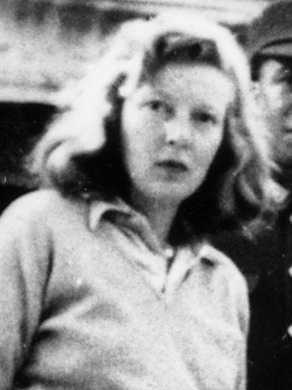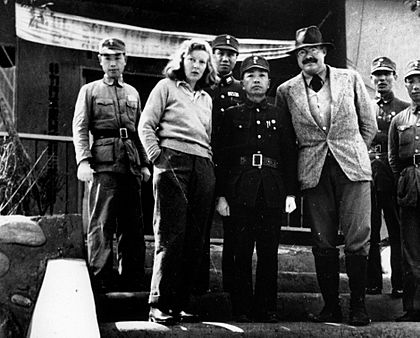Martha Gellhorn facts for kids
Quick facts for kids
Martha Gellhorn
|
|
|---|---|

Gellhorn, 1941
|
|
| Born | Martha Ellis Gellhorn 8 November 1908 St. Louis, Missouri, US |
| Died | 15 February 1998 (aged 89) London, England |
| Occupation | Author, war correspondent |
| Period | 1934–1989 |
| Genre | War, travel |
| Spouse |
T. S. Matthews
(m. 1954; div. 1963) |
Martha Ellis Gellhorn (8 November 1908 – 15 February 1998) was an American novelist, travel writer, and journalist who is considered one of the great war correspondents of the 20th century.
Gellhorn reported on virtually every major world conflict that took place during her 60-year career. She was also the third wife of American novelist Ernest Hemingway, from 1940 to 1945. She died in 1998. The Martha Gellhorn Prize for Journalism is named after her.
Contents
Early life
Gellhorn was born on 8 November 1908, in St. Louis, Missouri, the daughter of Edna Fischel Gellhorn, a suffragist, and George Gellhorn, a German-born doctor. Her father and maternal grandfather were Jewish, and her maternal grandmother came from a Protestant family. Her brother Walter became a noted law professor at Columbia University, and her younger brother Alfred was an oncologist and dean of the University of Pennsylvania School of Medicine.
At age 7, Gellhorn participated in "The Golden Lane," a rally for women's suffrage at the Democratic Party's 1916 national convention in St. Louis. Women carrying yellow parasols and wearing yellow sashes lined both sides of a main street leading to the St. Louis Coliseum. A tableau of the states was in front of the Art Museum; states that had not enfranchised women were draped in black. Gellhorn and another girl, Mary Taussig, stood in front of the line, representing future voters.
In 1926, Gellhorn graduated from John Burroughs School in St. Louis, and enrolled in Bryn Mawr College, several miles outside Philadelphia. The following year, she left without having graduated to pursue a career as a journalist. Her first published articles appeared in The New Republic. In 1930, determined to become a foreign correspondent, she went to France for two years, where she worked at the United Press bureau in Paris, but was fired. She spent years traveling Europe, writing for newspapers in Paris and St. Louis and covering fashion for Vogue. She became active in the pacifist movement, and wrote about her experiences in her 1934 book What Mad Pursuit.
Returning to the United States in 1932, Gellhorn was hired by Harry Hopkins, whom she had met through her friendship with First Lady Eleanor Roosevelt. The Roosevelts invited Gellhorn to live at the White House, and she spent evenings there helping Eleanor Roosevelt write correspondence and the first lady’s “My Day” column in Women's Home Companion. She was hired as a field investigator for the Federal Emergency Relief Administration (FERA), created by Franklin D. Roosevelt to help end the Great Depression. Gellhorn traveled around the United States for FERA to report on how the Depression was affecting the country. She first went to Gastonia, North Carolina. Later, she worked with Dorothea Lange, a photographer, to document the everyday lives of the hungry and homeless. Their reports became part of the official government files for the Great Depression. They were able to investigate topics that were not usually open to women of the 1930s. She drew on her research to write a collection of short stories, The Trouble I've Seen (1936). Gellhorn was fired from FERA.
War in Europe and marriage to Hemingway
Gellhorn met Ernest Hemingway during a 1936 Christmas family trip to Key West, Florida. Gellhorn had been hired to report for Collier's Weekly on the Spanish Civil War, and the pair decided to travel to Spain together. They celebrated Christmas of 1937 in Barcelona. In Germany, she reported on the rise of Adolf Hitler; in the spring of 1938, months before the Munich Agreement, she was in Czechoslovakia. After the outbreak of World War II, she described these events in the novel A Stricken Field (1940). She later reported the war from Finland, Hong Kong, Burma, Singapore, and England.
In June 1944, Gellhorn applied to the British government for press accreditation to report on the Normandy landings; her application, like those of all female journalists, was denied. Lacking official press credentials, she posed as a nurse and was allowed onto a hospital ship where she promptly locked herself in a bathroom. Upon landing two days later she saw the many wounded and became a stretcher-bearer. Later she recalled, "I followed the war wherever I could reach it." She was the only woman to land at Normandy on D-Day on 6 June 1944.
She was among the first journalists to report from Dachau concentration camp after it was liberated by U.S. troops on 29 April 1945.
Gellhorn and Hemingway lived together off and on for four years, before marrying in November 1940. Hemingway was resentful of Gellhorn's long absences during her reporting assignments when she left their Finca Vigía estate near Havana in 1943 to cover the Italian Front. Hemingway, however, would later go to the front just before the Normandy landings, and Gellhorn also went, with Hemingway trying to block her travel. When she arrived by means of a dangerous ocean voyage in war-torn London (he had landed there eleven days before her, via an RAF flight on which she had arranged a seat for him), she told him she had had enough. After four contentious years of marriage, they divorced in 1945.
The 2012 film Hemingway & Gellhorn is based on these years. The 2011 documentary film No Job for a Woman: The Women Who Fought to Report WWII features Gellhorn and how she changed war reporting.
Later career
After the war, Gellhorn worked for the Atlantic Monthly, covering the Vietnam War and the Arab-Israel conflicts in the 1960s and 70s. She passed her 70th birthday in 1979 but continued working in the following decade, covering the civil wars in Central America. As she approached 80, Gellhorn began to slow down physically and although she still managed to cover the U.S. invasion of Panama in 1989, she finally retired from journalism as the 1990s began. An operation for cataracts was unsuccessful and left her with permanently impaired vision. Gellhorn announced that she was "too old" to cover the Balkan conflicts in the 1990s. She did manage one last overseas trip to Brazil in 1995 to report on poverty in that country, which was published in the literary journal Granta. This last feat was accomplished with great difficulty as Gellhorn's eyesight was failing, and she could not read her own manuscripts.
Gellhorn's books include a collection of articles on war, The Face of War (1959); The Lowest Trees Have Tops (1967), a novel about McCarthyism; an account of her travels (including one trip with Hemingway), Travels with Myself and Another (1978); and a collection of her peacetime journalism, The View from the Ground (1988).
Peripatetic by nature, Gellhorn reckoned that in a 40-year span of her life, she had created homes in 19 locales.
Personal life
Gellhorn met Ernest Hemingway in Key West, Florida, in 1936. They married in 1940. Gellhorn resented her reflected fame as Hemingway's third wife, remarking that she had no intention of "being a footnote in someone else's life." As a condition for granting interviews, she was known to insist that Hemingway's name not be mentioned. As she put it once, "I've been a writer for over 40 years. I was a writer before I met him and I was a writer after I left him. Why should I be merely a footnote in his life?"
In 1954, she married the former managing editor of Time Magazine, T. S. Matthews. She and Matthews divorced in 1963. She stayed in London for some time before moving to Kenya and then to Kilgwrrwg near Devauden in Gwent, South Wales, She was very taken by the niceness of the Welsh people and lived there from 1980 to 1994 before finally returning to London because of her ill-health.
In 1949, Gellhorn adopted a boy, Sandro, from an Italian orphanage. He was formally renamed George Alexander Gellhorn, and widely called Sandy. Gellhorn was reportedly a devoted mother for a time but was not by nature maternal. She left Sandy in the care of relatives in Englewood, New Jersey, for long periods as she travelled, and he eventually attended boarding school.
Gellhorn and the writer Sybille Bedford met in Rome in 1949 and developed a strong platonic friendship. It long survived volatility on both sides and entailed much moral, creative and financial support for her friend on Gellhorn's part until she ended the friendship in the early 1980s.
Death and legacy
In her last years, Gellhorn was in frail health. On 15 February 1998, she died in London.
The Martha Gellhorn Prize for Journalism was established in 1999 in her honor.
In 2019, a blue English Heritage plaque was unveiled at Gellhorn's former London home, the first to feature the dedication of "war correspondent".
In 2021 a Purple Plaque was placed on the cottage she lived in near Kilgwrrwg, as part of a national scheme to commemorate remarkable women.
In popular culture
On 5 October 2007, the United States Postal Service announced that it would honor five 20th-century journalists with first-class rate postage stamps, to be issued on 22 April 2008: Martha Gellhorn; John Hersey; George Polk; Ruben Salazar; and Eric Sevareid. Postmaster General Jack Potter announced the stamp series at the Associated Press Managing Editors Meeting in Washington, D.C.
In 2011, Gellhorn was the subject of an hour-long episode of the World Media Rights series Extraordinary Women, which airs on the BBC, and periodically in the United States on PBS.
In 2012, Gellhorn was played by Nicole Kidman in Philip Kaufman's film, Hemingway & Gellhorn.
Martha Gellhorn's relationship with Ernest Hemingway is the subject of Paula McLain's 2018 novel, Love and Ruin. In April 2021, Hemingway, a three-episode, six-hour documentary recapitulation of Hemingway's life, labors, and loves, debuted on the Public Broadcasting System. It was co-produced and directed by Ken Burns and Lynn Novick. It contains considerable footage and photographs of Gellhorn, who is voiced by Meryl Streep, and recollections of those who knew her and her life with Hemingway first-hand.
See also
 In Spanish: Martha Gellhorn para niños
In Spanish: Martha Gellhorn para niños




